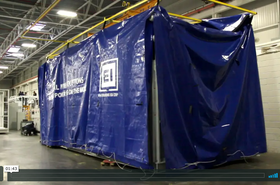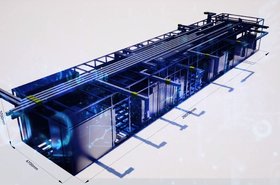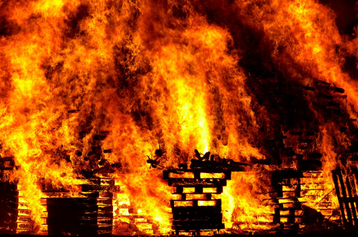Fire incidents in the data center may not make the news too often, but they certainly do occur. Naturally, as data centres are concerned with high power availability and efficiency, fire damage often goes unreported in an attempt to limit reputation damage, which accounts for the obscure nature of the topic.
This culture of denial can have a significant impact on data center stability, contributing to risk complacency. The less awareness there is about fire risk in the data center, the less likely data center operators may recognise fire protection as a priority. Although fires may not be the most common hazard in the data center, they are certainly one of the most unpredictable, accounting for the longest periods of downtime with the greatest potential to cause harm: not only to critical operation but also to human life.
There is no fixed cost of downtime in the data center, and the tangible cost will vary from one data center to the other depending on a great number of variables. However, it is generally accepted that the potential impact of downtime on data center productivity is too adverse to risk in most applications. Due to the critical nature of operations, power availability of less than 99.99 percent is simply not acceptable if businesses are to operate efficiently.
Where are the risks?
Demand for online data storage, networking and bandwidth has grown exponentially over the past decade as a result of the rapid growth of ecommerce and cloud computing across the world, changing the dynamics of key business processes and consumer behaviour.
As the demand for data has increased, the complexity of data center operations has also increased, giving rise to more potential fire risks:
- Electrical equipment
Data storage equipment is highly sensitive to temperature changes. A slight increase in the temperature because of fire may create serious problems for servers and other equipment/hardware. Standby power generation equipment can also be a source of fire in large data centers. Backup generator rooms that contain hydrocarbon fuels such as diesel, which has a flashpoint of 60 degrees celsius, can be subject to intense fires.
- Cabling
Although data centre cabling alone may not possess enough energy to instigate a fire, it can present a serious hazard if not maintained and managed properly. For instance faulty electrical cables could spark, initiating a fire that spreads throughout the system. Cables, therefore, should be checked regularly for any issues. Cable management is also critical to fire avoidance. Cables that are routed in a neat and easily accessible fashion are less likely to be bent or damaged, reducing the likelihood of a fault. The use of raised floors and suspended ceilings also present a hazard in the data center as the enclosed nature of these spaces mean that cables are more likely to overheat. When a fire breaks out it may be difficult to identify the issue immediately due to lack of visibility.
- HVAC infrastructure
As data center power capacities grow, so too do the HVAC systems required to maintain them. In large data centers, the use of fire suppression systems is quite challenging because of the high airflow and increased power density of the servers. If HVAC equipment is not competent in reducing heat dissipation of the power infrastructure, there is an increased fire risk. Additionally, as HVAC equipment is comprised of electrical components and gas refrigerants, it can also present a fire hazard if it is not properly maintained.
- External hazards
While fire suppression in the data center typically focuses on internal factors, it is also important to consider external factors. These external hazards can take the form of accidental/intentional fires, wildfires and so on. and can be difficult to mitigate as we have little control over them. By installing fire-rated power distribution, along with alarm and suppression systems, you can prolong the integrity of your data center infrastructure until rapid response is deployed to extinguish the fire.
The role of fire-rated power distribution
The two basic principle of fire safety are avoid and protect. To keep the fire suppressing system and allied equipment running during a fire condition, uninterrupted power distribution is critical. Fire-rated busbar trunking system can be operational for a period of up to 120 minutes – or even 180 minutes depending on the fire ratings during the fire incidents. The fire-retardant self-extinguishing resin cased busbar eliminates any immediate risk of power loss due to fire. This can give time for fire to be extinguished.
For example, a busbar trunking solution with a certified fire rating of F180 can supply continuous current under fire conditions for 3 hours before the integrity of the power supply is impacted. This can slow the spread of fire throughout a facility, protecting the integrity of critical power infrastructure and also human life as infrastructure such as elevators and fire suppression systems can continue to operate to facilitate a safe and efficient evacuation procedure.
The applicable standard for fire-rated busduct
There are various fire-resistant standards specified for low voltage busduct trunking systems. The fire ratings indicate the types of fire, duration of the test, with/without mechanical impact, water spray during the test, and most importantly power supply integrity under these hostile conditions.
- BS IEC 60331-1: 2019 – Tests for electric cables under fire conditions; circuit integrity;
- BS 8602:2013 – Method for assessment of fire integrity of cast resin busbar trunking systems for the safety-critical power distribution to life safety and firefighting systems;
- BS 6387:2013 (CWZ Protocol) – Test method for resistance to fire of cables required to maintain circuit integrity under fire conditions. Fire-resistant cables are classified by a sequence of symbols (for example, CWZ) in accordance with the fire resistance criteria they meet, the selected test temperature and the length of the fire resistance test per BS 6387;
- NFPA 75 – Standard for the fire protection of IT equipment;
- ISO 834 – Fire resistance tests- elements of building construction;
- ATEX & IECEx – ATEX certification is given to equipment that has gone through rigorous testing outlined by European Union directives and proved safe to use in specific environments with explosive atmospheres, according to the zone/s they are certified to be used in.
More...
-

E+I Engineering: Global Modular Power Solutions
Watch the latest video by E+I
-

Sponsored Frozen out?
The Texas power outages had data center operators rushing to re-assess their business continuity plans. But what really happened, and what are the real lessons that can be learned?
-

E+I Engineering: 60MW Hyperscale Modular Data Centre
Watch the latest video from E+I.


